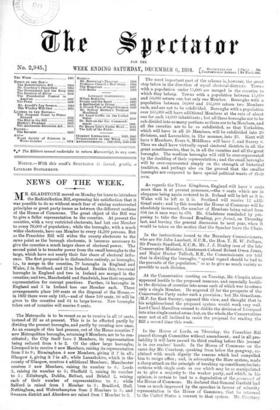The most important part of the scheme is, however, the
great step taken in the direction of equal electoral districts. Towns with a population under 15,000 are merged in the counties to which they belong. Towns with a population between 15,000 and 50,000 return one, but only one Member. Boroughs with a population between 50,000 and 165,000 return two Members each, and are not to be subdivided. Boroughs with a population over 165,000 will have additional Members at the rate of about one for each 54,000 inhabitants ; but all these boroughs are to be sub-divided into as many portions as there are to be Members, and all the counties are to be so subdivided, so that Yorkshire, which will have in all 26 Members, will be subdivided into 26 divisions, and Lancashire, in like manner, into 23. Kent will have 8 Members, Essex 8, Middlesex will have 7, and Surrey 6. Thus we shall have virtually equal electoral districts in all the great constituencies, that is, in all the counties and all the great boroughs. The medium boroughs will still be over-represented by the doubling of their representation ; and the small boroughs will be over-represented simply on the strength of historical tradition, and perhaps also on the ground that the smaller boroughs are supposed to have special political wants of their own.


















































